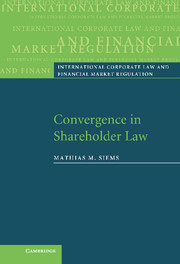Book contents
- Frontmatter
- Contents
- Preface and acknowledgments
- List of abbreviations
- Table of cases
- Table of legislation
- Introduction
- PART I The object and course of the investigation
- 1 Dimensions of convergence in shareholder law
- PART II The status quo of convergence
- PART III Developmental trends and patterns
- PART IV Conclusion
- References
- Index
1 - Dimensions of convergence in shareholder law
Published online by Cambridge University Press: 15 December 2009
- Frontmatter
- Contents
- Preface and acknowledgments
- List of abbreviations
- Table of cases
- Table of legislation
- Introduction
- PART I The object and course of the investigation
- 1 Dimensions of convergence in shareholder law
- PART II The status quo of convergence
- PART III Developmental trends and patterns
- PART IV Conclusion
- References
- Index
Summary
The delimitation of this book follows from the spatial, objective, temporal and legal methodological dimensions of convergence in shareholder law. The ‘spatial dimension’ (section 1 below) will include the legal bases of international organizations, the EU, the UK, the US, Germany, France, Japan and China. In the discussion on ‘objective dimension’ (section II below), it will be clarified what kind of companies and investors ‘shareholder law’ covers. In the discussion on ‘temporal dimension’ (section III below), the question of whether and how far the current process of convergence is to be regarded as a continuation or endpoint of the developments to date will be considered. Finally, the section on ‘methodological dimension’ (section IV below) will set out further steps of this monograph.
The spatial dimension: the legal systems covered
In selecting the legal systems to be studied, it is sensible to restrict their number, though without thereby narrowing the comprehensiveness of the study. Accordingly, I will consider the law of the US, the UK, Germany, France, Japan and China as well as international legal bases.
Further specification is needed for the EU, the US and China. At the European level, in addition to harmonization through directives, the European Company (Societas Europaea, SE) in particular now has to be taken into account. The focus here will be on the European law on the SE. This is not intended to give the impression that the SE is a uniform European legal form.
- Type
- Chapter
- Information
- Convergence in Shareholder Law , pp. 7 - 28Publisher: Cambridge University PressPrint publication year: 2007
- 2
- Cited by



